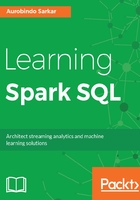
Understanding DataFrames and Datasets
A DataFrame is similar to a table in a relational database, a pandas dataframe, or a data frame in R. It is a distributed collection of rows that is organized into columns. It uses the immutable, in-memory, resilient, distributed, and parallel capabilities of RDD, and applies a schema to the data. DataFrames are also evaluated lazily. Additionally, they provide a domain-specific language (DSL) for distributed data manipulation.
Conceptually, the DataFrame is an alias for a collection of generic objects Dataset[Row], where a row is a generic untyped object. This means that syntax errors for DataFrames are caught during the compile stage; however, analysis errors are detected only during runtime.
DataFrames can be constructed from a wide array of sources, such as structured data files, Hive tables, databases, or RDDs. The source data can be read from local filesystems, HDFS, Amazon S3, and RDBMSs. In addition, other popular data formats, such as CSV, JSON, Avro, Parquet, and so on, are also supported. Additionally, you can also create and use custom data sources.
The DataFrame API supports Scala, Java, Python, and R programming APIs. The DataFrames API is declarative, and combined with procedural Spark code, it provides a much tighter integration between the relational and procedural processing in your applications. DataFrames can be manipulated using Spark's procedural API, or using relational APIs (with richer optimizations).
In the early versions of Spark, you had to write arbitrary Java, Python, or Scala functions that operated on RDDs. In this scenario, the functions were executing on opaque Java objects. Hence, the user functions were essentially black boxes executing opaque computations using opaque objects and data types. This approach was very general and such programs had complete control over the execution of every data operation. However, as the engine did not know the code you were executing or the nature of the data, it was not possible to optimize these arbitrary Java objects. In addition, it was incumbent on the developers to write efficient programs that were dependent on the nature of their specific workloads.
In Spark 2.0, the main benefit of using SQL, DataFrames, and Datasets is that it's easier to program using these high-level programming interfaces while reaping the benefits of improved performance, automatically. You have to write significantly fewer lines of code and the programs are automatically optimized and efficient code is generated for you. This results in better performance while significantly reducing the burden on developers. Now, the developer can focus on the "what" rather than the "how" of something that needs to be accomplished.
The Dataset API was first added to Spark 1.6 to provide the benefits of both RDDs and the Spark SQL's optimizer. A Dataset can be constructed from JVM objects and then manipulated using functional transformations such as map, filter, and so on. As the Dataset is a collection of strongly-typed objects specified using a user-defined case class, both syntax errors and analysis errors can be detected at compile time.
The unified Dataset API can be used in both Scala and Java. However, Python does not support the Dataset API yet.
In the following example, we present a few basic DataFrame/Dataset operations. For this purpose, we will use two restaurant listing datasets that are typically used in duplicate records detection and record linkage applications. The two lists, one each from Zagat's and Fodor's restaurant guides, have duplicate records between them. To keep this example simple, we have manually converted the input files to a CSV format. You can download the original dataset from http://www.cs.utexas.edu/users/ml/riddle/data.html.
First, we define a case class for the records in the two files:
scala> case class RestClass(name: String, street: String, city: String, phone: String, cuisine: String)
Next, we create Datasets from the two files:
scala> val rest1DS = spark.sparkContext.textFile("file:///Users/aurobindosarkar/Documents/SparkBook/data/zagats.csv").map(_.split(",")).map(attributes => RestClass(attributes(0).trim, attributes(1).trim, attributes(2).trim, attributes(3).trim, attributes(4).trim)).toDS()
scala> val rest2DS = spark.sparkContext.textFile("file:///Users/aurobindosarkar/Documents/SparkBook/data/fodors.csv").map(_.split(",")).map(attributes => RestClass(attributes(0).trim, attributes(1).trim, attributes(2).trim, attributes(3).trim, attributes(4).trim)).toDS()
We define a UDF to clean up and transform the phone numbers in the second Dataset to match the format in the first file:
scala> def formatPhoneNo(s: String): String = s match {case s if s.contains("/") => s.replaceAll("/", "-").replaceAll("- ", "-").replaceAll("--", "-") case _ => s }
scala> val udfStandardizePhoneNos = udf[String, String]( x => formatPhoneNo(x) )
scala> val rest2DSM1 = rest2DS.withColumn("stdphone", udfStandardizePhoneNos(rest2DS.col("phone")))

Next, we create temporary views from our Datasets:
scala> rest1DS.createOrReplaceTempView("rest1Table")
scala> rest2DSM1.createOrReplaceTempView("rest2Table")
We can get a count of the number of duplicates, by executing a SQL statement on these tables that returns the count of the number of records with matching phone numbers:
scala> spark.sql("SELECT count(*) from rest1Table, rest2Table where rest1Table.phone = rest2Table.stdphone").show()

Next, we execute a SQL statement that returns a DataFrame containing the rows with matching phone numbers:
scala> val sqlDF = spark.sql("SELECT a.name, b.name, a.phone, b.stdphone from rest1Table a, rest2Table b where a.phone = b.stdphone")
The results listing the name and the phone number columns from the two tables can be displayed to visually verify, if the results are possible duplicates:

In the next section, we will shift our focus to Spark SQL internals, more specifically, to the Catalyst optimizer and Project Tungsten.